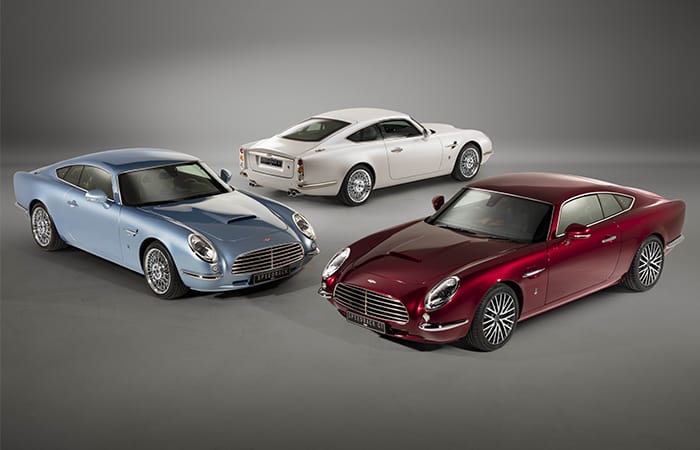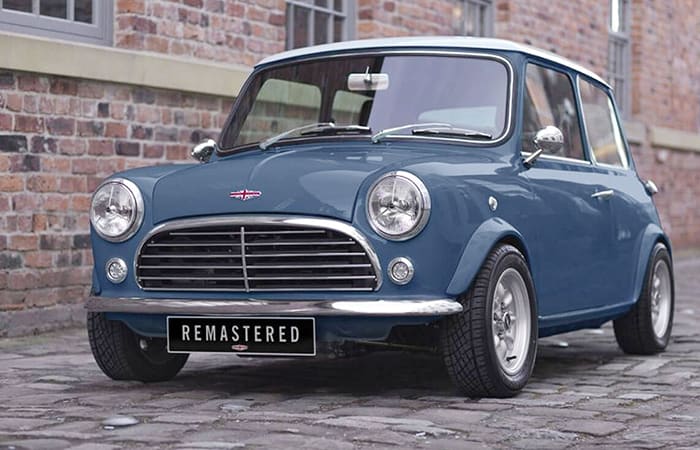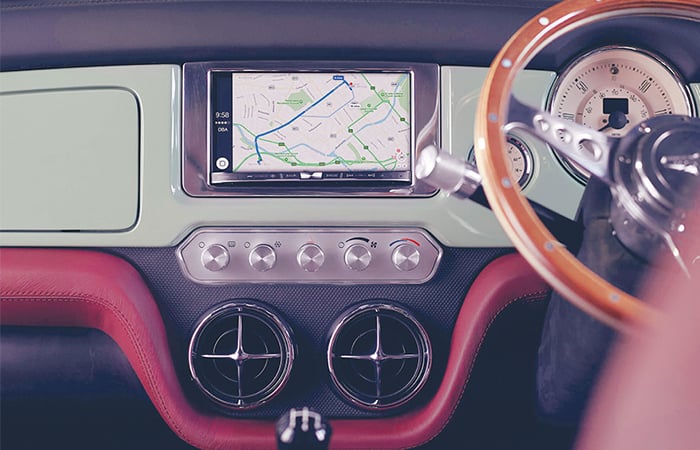 From the outside, David Brown Automotive has little to mark it out from any other small engineering business on an industrial estate: it occupies a nondescript modern building in Silverstone Park, adjacent to the legendary racing circuit at the heart of Northamptonshire’s so-called ‘Motorsport Valley’, where the shrill note of a racing engine rises and falls in gurgles and screeches as it negotiates the corners.
From the outside, David Brown Automotive has little to mark it out from any other small engineering business on an industrial estate: it occupies a nondescript modern building in Silverstone Park, adjacent to the legendary racing circuit at the heart of Northamptonshire’s so-called ‘Motorsport Valley’, where the shrill note of a racing engine rises and falls in gurgles and screeches as it negotiates the corners.
However, the company badge on the outside of the building, with its elongated Union Jack styling, has a certain sports car swagger. When you get inside, that swagger becomes as obvious as Sean Connery in a sharp silver-grey suit approaching a vintage Aston Martin. Lined up on the factory floor is a rank of cars that seem to come from another decade: from the front resembling a classic E-type Jaguar, blending at the rear into a subtly finned form recalling James Bond’s legendary Aston Martin DB5.
There are even echoes of the English Electric Lightning fighter jet in the curve of its flanks; but these are no vintage vehicles – they are very obviously brand new. Facing these objects of automotive desire are very familiar forms: classic Austin Minis, goggle-eyed and far more diminutive than their new BMW reincarnation, also looking brand new in polished pastel, cream and brown shades with leather straps across their bonnets. Has a fragment of the Swinging Sixties materialised in this modern industrial unit?

The man behind this operation is the eponymous David Brown, a trim figure in his early sixties, comfortable in jeans, boots and leather jacket and very much looking the part of the owner of a sports-car marque.
The company’s customer suite is a fitting place for a chat, overlooking the factory floor and bedecked with samples of paint finishes and swatches of leather for prospective owners of DBA vehicles to choose how they would like their new purchase to look.
Brown is the son of an engineer, also called David Brown. His roots are around the North Yorkshire market town of Knaresborough, where Brown Sr originally worked as a timber-master, felling trees and lugging them from local forestry to sawmills using a variety of tractors. While recuperating from a serious accident when a tractor overturned on top of him while he was trying to use it to pull out a particularly reluctant trunk, Brown Sr turned to engineering design to come up with a customised crane that could perform the job safely. After recovering, he started a new business designing and building heavy vehicles for agriculture, construction and quarrying. An articulated dump-truck design was particularly successful, and led to the business, DJB Engineering, eventually being acquired by Caterpillar after a long partnership.
Brown Jr then began a period of entrepreneurship in his own right. “I had a talent for starting companies,” he says. “I started with the sort of companies of which I had been a customer, such as bars, restaurants and men’s clothing – with a certain arrogance, I suppose, thinking that I could do it better.”
Profiting from the sale of these businesses, he became, by any metric, comfortably off, and indulged in what many would see as the fairly stereotypical hobby of classic car endurance rallying. “I entered a rally in the south of France, and a friend of mine loaned me his classic Ferrari Daytona convertible to drive. It was the dream car of my young adulthood and I was so looking forward to it. But when I picked it up at Nice airport, I was instantly disappointed. The steering was heavy, the brakes by any standard poor and it was woefully underpowered. It was also very uncomfortable. Perhaps fortunately, on the second day of the rally it got stuck in second gear and I had to abandon the rally. I rented a standard modern Peugeot to follow the rest of the race, and it was comparatively a joy to drive: it had air-conditioning, it had a radio, it had power steering and the brakes worked.
“Several of the other competitors offered to lend me their classics for a day, ostensibly so I could continue with the rally experience but actually because they just wanted to spend the day driving a more pleasant car. It got me thinking, wouldn’t it be great if you could combine the style of those beautiful late 1960s-early 1970s sports cars with contemporary power and all the features we take for granted?”
'Nobody needs a car like this. You have to want one... and enough people do that it’s viable for me to build them'
Thus was born the idea for the DBA Speedback GT, the alluring Jaguar/Aston Martin/Lightning cross sitting below in the factory. “I’m not an engineer by training,” Brown says, “but from knowing my family automotive business, and from building my own cars for rallying, I knew how we could make something like this at volume – admittedly never huge volumes, but enough I could make a business out of it.”
Brown is under no illusions that he isn’t in a luxury business. “Look, nobody needs a car like this. You have to want one, but enough people do that it’s viable for me to build them.”
The idea was to build a classic GT – a real gran turismo, a car designed to cover long distances in comfort. To design it, Brown called on ex-Land Rover designer Alan Mobberley, who came out of retirement to work on the project. “You might not believe it, considering the way the Speedback looks, but we didn’t go into it with any particular final shape in mind. We surrounded ourselves with icons from the era, pictures of classic cars and Sophia Loren on the wall and got ourselves into the 1960s mood. We might have drunk a few bottles of wine. And that is the design that came out.”
Mechanically, the Speedback GT is based on a Jaguar XKR chassis, 503bhp, 5-litre supercharged engine, transmission and suspension, but everything visible is custom-built. The bodywork is aluminium, made by a specialist subcontractor and formed using the old panel-shaping technique of the English wheel. Interior details are polished walnut, and the upholstery is handmade by an in-house team. “I’m very keen on keeping that craft aspect of the business alive,” Brown says. “But equally, there is a place for new technology as well.” Along one wall of the upholstery studio, a series of small 3D printers hum busily, turning out prototypes of interior details and accessories.

Other modern features include LED lights, performance brakes, climate control, electrically folding door mirrors, parking sensors, satnav, Bluetooth and a high-end audio system. And the price tag matches: the “standard model” costs around £600,000, while the “Silverstone” edition, consciously styled more after a fighter jet, costs a cool £750,000. Nevertheless, there are plenty of customers and the limited edition run is sold out, with buyers from around the world. For those with not-so-deep (but still pretty capacious) pockets, DBA’s other model, the ‘Mini Remastered’ retails at a slightly more modest £99,000.
Rather than being a new car like the Speedback GT, the Minis literally are "remastered": the company buys vintage Minis, strips them back to the chassis, and rebuilds them from there. The original bodywork is lovingly replicated in aluminium, with the distinctive seams (which marked where the original panels were joined together) omitted to give a smoother profile; new suspension (solid rubber, like the old version: “We tried springs, but they just don’t feel the same.”), restored engine and gearbox and new interior, including dashboard, installed, with all the audio and navigation devices you would expect on a new car. The car retains the original registration, vehicle identification number, and so on, from the donor vehicle. Brown expects to build 50-100 per year.

He remains committed to his mixture of manufacturing techniques from the past and present. “What you see here is a great example of a combination of traditional skills and contemporary ways of manufacturing and measurement,” he says. “We are lucky to have some great suppliers and people with real heritage skills: craftsman skills. Our suppliers go the extra mile for us: when we ordered paint for the Speedback, the samples we were sent exceeded the standard we had asked for in our brief. The brand stands for reimagining products from the past using the finest British craftsmanship and materials.
“Leave styling to one side for a minute, because styling is a product of time, but if any of the manufacturers of the 1960s had access to the things that we can use, they would have used them in exactly the same way that we are using them now. I do not want to get trapped into nostalgia for nostalgia’s sake. If you look at the panel joins on the Speedback, they are superb, and the only way we can get that quality is by using digital measurement.”
As we walk around the trim room after our conversation, the leather workers are using tools made from whalebone and stitching by hand while the Rolling Stones’ Paint It Black emerges from the digital radio that sits between the busy 3D-printing machines. These machines, Brown tells me, are making a prototype for the lining for a picnic hamper to be offered to Speedback GT owners on their car’s birthday, which will be trimmed in leather matching their upholstery – in fact, from the same hide. It seems utterly fitting.










Water Sector Talent Exodus Could Cripple The Sector
Maybe if things are essential for the running of a country and we want to pay a fair price we should be running these utilities on a not for profit...